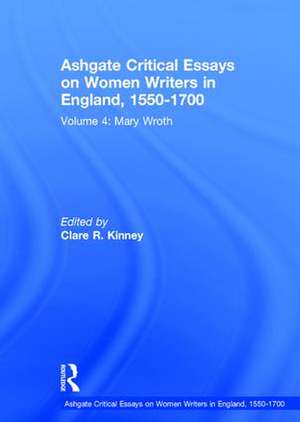Ashgate Critical Essays on Women Writers in England, 1550-1700: Volume 4: Mary Wroth: Ashgate Critical Essays on Women Writers in England, 1550-1700
Editat de Clare R. Kinneyen Limba Engleză Hardback – 31 iul 2009
Preț: 472.44 lei
Preț vechi: 614.33 lei
-23% Nou
Puncte Express: 709
Preț estimativ în valută:
90.40€ • 94.64$ • 74.80£
90.40€ • 94.64$ • 74.80£
Comandă specială
Livrare economică 15-29 martie
Doresc să fiu notificat când acest titlu va fi disponibil:
Se trimite...
Preluare comenzi: 021 569.72.76
Specificații
ISBN-13: 9780754660828
ISBN-10: 0754660826
Pagini: 556
Ilustrații: Illustrations
Dimensiuni: 169 x 244 x 39 mm
Greutate: 1.3 kg
Ediția:1
Editura: Taylor & Francis
Colecția Routledge
Seria Ashgate Critical Essays on Women Writers in England, 1550-1700
Locul publicării:Oxford, United Kingdom
ISBN-10: 0754660826
Pagini: 556
Ilustrații: Illustrations
Dimensiuni: 169 x 244 x 39 mm
Greutate: 1.3 kg
Ediția:1
Editura: Taylor & Francis
Colecția Routledge
Seria Ashgate Critical Essays on Women Writers in England, 1550-1700
Locul publicării:Oxford, United Kingdom
Cuprins
Contents: Introduction; Bibliography; Part I Pamphilia to Amphilanthus: 'And thus leave off': reevaluating Mary Wroth's Folger manuscript, V.a.104, Heather Dubrow; 'Shall I turne blabb?': circulation, gender, and subjectivity in Lady Mary Wroth's sonnets, Jeff Masten; Rewriting lyric fictions: the role of the Lady in Lady Mary Wroth's Pamphilia to Amphilanthus, Naomi J. Miller; The labyrinth as style in Pamphilia to Amphilanthus, Mary Moore; Lady Mary Wroth's Pamphilia to Amphilanthus: the politics of withdrawal, Rosalind Smith. Part II Urania I and II: A pack of lies in a looking glass: Lady Mary Wroth's Urania and the magic mirror of romance, Jennifer Lee Carrell; 'The Great Cham': East meets West in Lady Mary Wroth's Urania, Sheila T. Cavanagh; 'Beleeve this butt a fiction': female authorship, narrative undoing and the limits of romance in The Second Part of the Countess of Montgomery's Urania, Clare R. Kinney; The biopolitics of romance in Mary Wroth's The Countess of Montgomery's Urania, Mary Ellen Lamb; Reading romances: the handwritten ending of Mary Wroth's Urania in the UCLA Library copy, Susan Light; Textual crimes and punishment in Mary Wroth's Urania, Shannon Miller; The constant subject: instability and female authority in Wroth's Urania poems, Maureen Quilligan; The strang[e] constructions of Mary Wroth's Urania: Arcadian romance and the public realm, Paul Salzman. Part III Love's Victory: Love's Victory, Barbara K. Lewalski; Deciphering women's pastoral: coded language in Wroth's Love's Victory, Josephine A. Roberts; 'Here is a sport will well befit this time and place': allusion and delusion in Mary Wroth's Love's Victory, Marion Wynne-Davies. Part IV Contexts: 'A Sydney, though un-named': Ben Jonson's influence in the manuscript and print circulation of Lady Mary Wroth's writings, Michael G. Brennan; 'Yet tell me some such fiction': Lady Mary Wroth's Urania and the 'femininity' of romance, Helen Hackett; 'Your vertuous and learned Aunt': the Countess of Pembroke as a mentor to Mary Wroth, Margaret P. Hannay; Boredom and whoredom: reading Renaissance women's sonnet sequences, Elizabeth Hanson; More I still undoe: Louise Labé, Mary Wroth and the Petrarchan discourse, Roger Kuin; The politics of genre in early women's writing: the case of Lady Mary Wroth, Cristina Luckyj; Lady Mary Wroth in the house of Busirane, Jacqueline T. Miller; Agency and marriage in the fictions of Lady Mary Wroth and Margaret Cavendish, Duchess of Newcastle, Anne Shaver; Index.
Notă biografică
Clare R. Kinney, Associate Professor of English, University of Virginia, USA
Descriere
Research into the scholarly work on Lady Mary Wroth, whose Urania and Pamphilia to Amphilanthus constitute the first romance and the first sonnet sequence to be published by an Englishwoman, has seen many new developments in the last twenty-five years. This volume gathers together some of the most striking recent criticism addressing Wroth's oeuvre; many of its essays also discuss the intellectual and cultural contexts in which she wrote. The collection is prefaced by an extended editorial overview of scholarship in the field.







